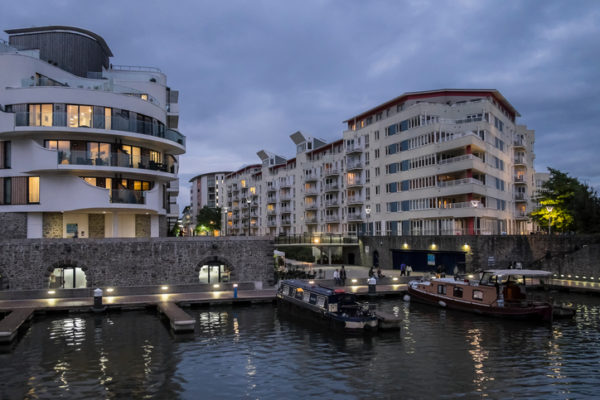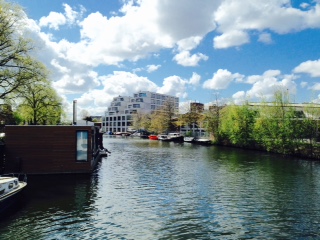Introducing the PARCOUR project – an exploration of urban redevelopment in Brazil, the Netherlands and the UK
Project overview

The Public Accountability to Residents in Contractual Urban Redevelopment (PARCOUR) project is a three-year project exploring how previously used land is redeveloped. The project includes nine case studies across three countries: Brazil, the Netherlands and the United Kingdom. Previously developed land, or brownfield sites, offer towns and cities the opportunity to create new infrastructure that can be used as public, office or industrial space and housing to meet the needs of the community. The project is designed to provide new ways of understanding the importance of how the redevelopment process is governed, with a particular focus on the contracts between the public sector bodies and private developers who deliver the new schemes. The project is designed to explore how the public can benefit from public-private contracts in terms of what is delivered through the partnership.
Contracts are a form of regulation so it is important to understand how these agreements allow for the delivery of sustainable urban developments and delivering something that is in the real public interest. Several planning tools exist that influence what is delivered (e.g. contracts, deeds, regulations) and the study is designed to understand what impact these have on the agreements made and the type of schemes that are ultimately delivered.
The research involves interviews with the key people involved in the regeneration process both from the public sector and private developers. In addition, interviews will be conducted with members of the local community to explore the impact of the development and the challenges of bringing them forward. The research is qualitative in nature and therefore absolutes cannot be drawn from the findings. It will, however, be possible to identify elements of best practice that exist in each case study to demonstrate what could be undertaken elsewhere to ensure the public interest is protected as part of the redevelopment of any previously developed land or brownfield sites.
The final stage of the project is designed to compare the development processes in a two stage process: first of all between the cases within each of the three countries and secondly compare cases between each of the three countries involved in the study. This stage will identify what works well, what does not and examples of best practice that could be applied to improve the delivery of future brownfield redevelopments. This will be presented to academic audiences in each of the countries, and internationally, to the national and local government sectors and the developers of brownfield sites and previously developed land in general to ensure the research has the maximum impact possible. This will be achieved through presentations at conferences, the publication of academic papers, and seminars with people involved in the regeneration sector.
Case studies
The project is based around three case studies from each country and a summary of each of these is included below:
Brazil
Consorted Urban Operation Água Espraiada (OUCAE), São Paulo
The OUCAE comprises an area of 1400 ha in the southwest region of São Paulo, close to the airport and main highways. The project was launched in 2001 through Municipal Law No.13.260, which established the guidelines for delivery of this scheme. The project includes a number of interventions to improve the transport infrastructure, housing availability and office facilities in the city. This is being delivered by public companies São Paulo Urbanism (SP-Urbanismo) and São Paulo Works (SP-Obras), and the scheme is designed to improve the urban, environmental and housing conditions in the area.
Porto Maravilha, Rio de Janeiro

Porto Maravilha is a large-scale redevelopment project launched in 2009 affecting the old harbour of Rio de Janeiro and some neighbouring areas. It comprises an area of around 5 million m² (500 ha). This area is close to the main central business district and very central in the context of the Metropolitan Region of Rio de Janeiro. It is very well serviced by transport infrastructure and characterised by the presence of a rich historical and cultural heritage. The project aims to improve urban infrastructure and public services, recover historical buildings and sites, introduce new cultural attractions and touristic venues and enhance the supply of office, retail and residential spaces within the region.
PPP Casa Paulista, São Paulo
PPP Casa Paulista consists of a public-private partnership promoted by the government of the State of São Paulo aimed at producing low and middle-income housing in the central districts of the city of São Paulo. São Paulo’s central area has lost population for several decades due to a continued outflow of higher-income groups and the most dynamic economic activities towards new affluent neighbourhoods, most of them located in the southwest region of the city. The general target of the programme is to build 14,000 new housing units within the central districts; the building of these housing units will be delegated to the private sector through PPP contracts. The first project commenced at the end of 2015, and was due to be delivered by the end of 2016. The second stage of development is expected to start in 2017.
Netherlands
Central City District North, Amersfoort
The Central City District North used to be a degenerated industrial estate and railyard. In the late-1980s, the Dutch Ministry of Housing, Spatial Planning and the Environment selected this area to be redeveloped within the frame of a series of national Key Projects. These projects were the result of a new form of spatial planning policy of the national government, in which the national government was directly involved in urban redevelopment at project level. Prior to the commencement of the Key Projects, the planning tools of the national government had a generic character: rules and financial instruments simply shaped the conditions for local developments. By stepping in and assuming an active position, the national government embraced the concept of project-led development and set the stage for integrated urban development. As for the Central City District North, this project comprised the second part of a Key Project adjacent to Amersfoort’s railway station. The regeneration of the area (34 ha) began in 2008, and was completed in 2015. Today the Central City District North includes 1200 dwellings, 215.000m2 of office space, 10.000m2 of retail space, and cultural and leisure facilities such as a cinema, a museum, and the city’s archives.
Belvédère, Maastricht
The Belvédère brickwork factory closed in the 1980s and the land was left derelict for several decades. In 1999, the Dutch urbanist Frits Palmhout designed a masterplan for the regeneration of the entire area. One year later, the municipality of Maastricht and two major Dutch investors, BPF Bouwinvest and ING Real Estate, signed a letter of intent in which they agreed to analyse the opportunities to regenerate the area. This letter of intent was transformed into an official cooperation between the three parties on July 7, 2004. The formal establishment of this cooperation had become possible as the municipal council had officially agreed with the masterplan for Belvédère prior to this. Following the new agreement, a joint-venture was established in which each contractual party had a third of the shares. The joint-venture was supposed to buy the land in the Belvédère area, service it, and then sell it to the three parties again. After that, developers would be invited to come up with plans.
The 2004 plan for Belvédère included 4000 dwellings, 150.000m2 of office space, and a maximum of 40.000m2 of retail space. As well, the project would provide cultural, leisure, and hospitality services and general social facilities, and about 100 small and medium-sized companies in the area were asked to move to other locations in order to provide room for the Belvédère developments. Since 2004 a lot has changed, though, particularly due to the global financial crisis and its aftermath. The joint-venture was dismantled as private investors left the project scene, and the municipality was forced to reconsider its approach to the Belvédère area. Since the launch of a new approach to the project, in 2013, developments have commenced again.
Buiksloterham, Amsterdam

A gradual transformation characterizes the regeneration of the former industrial district of Buiksloterham (100 ha) in Amsterdam, on the northern banks of the IJ river. Changes in Amsterdam’s zoning plan have created opportunities for bringing housing into the mix here, and the municipality of Amsterdam also sees the area as an opportunity to host new enterprises in the creative, nautical, and media industry. The overarching objective is to create a sustainable mixed-use urban area, and the process is characterised by a high degree of interactive governance. That is, within the limitations of the law, there are several privately owned properties whose owners are allowed to develop their own projects within the ‘rules of the game’ of the development plan. In addition, a framework has been built for public space planning, and a general masterplan is deliberately absent.
The rules and the framework leave a lot of room for future developments. Approximately 1500 dwellings are currently in the development stage. In the next ten years, more than 3000 dwellings will be constructed. These developments include a number of self-build housing projects. The project is generally seen as a ‘living lab’ as it is based on a new business model.
United Kingdom
Canon’s Marsh/Harbourside, Bristol
Bristol Harbourside is a 7ha mixed-use development in central Bristol, to the west of the city centre. The site’s masterplan included 664 dwellings, up to 34,500m2 of office space and a 21,000m2 leisure development. The development was led by developers Crest Nicholson, with the masterplan completed by Edward Cullinan Architects and was delivered over 14 years, between 2001 and 2015. Prior to the approval of the Harbourside development, three phases of development took place in Canon’s Marsh adjacent to the site included in this research. The transit sheds to the north east of the site were converted into the Watershed media centre in 1982, Lloyds Bank built their headquarters in the late 1980s and ‘Millennium funding’ was used to develop Millennium Square, @Bristol and an IMAX cinema (now the Aquarium) in the late 1990s.
Gloucester Quays, Gloucester
The Gloucester Quays redevelopment was part of a wider redevelopment of the city of Gloucester. The Gloucester Heritage Urban Regeneration Company (GHURC) was set up by the local authority and South West Region Development Agency (SWRDA) to facilitate the development in 2004, having completed a masterplan for the regeneration of the docks in 2003. GHURC produced an Area Regeneration Framework in 2006 that outlined the 21 areas of previously developed land within seven key areas of the city that would be earmarked for redevelopment as part of a £1bn regeneration programme. This included Bakers Quay at Gloucester Docks that were to be redeveloped into a shopping area, with accommodation located above the shops. The scheme was delivered by a partnership of Peel Developments and British Waterways (now the Canal and River Trust), with Peel Developments responsible for running the shopping area as a designer clothes outlet (selling clothes at a discount) after it was developed. The development also included a new campus for the Gloucester College, a food superstore, a 90 bed hotel, office space, car parking and 1,000 dwellings.
Firepool, Taunton
The Firepool redevelopment is formed of nine different areas close to Taunton railway station all at various stages of redevelopment. The redevelopment with the former cattle market site, currently under negotiation between developers St Modwen and the Taunton Deane Borough Council, was rejected for outline planning permission in August 2016. Both parties are working hard to resubmit a revised plan at the time of writing. Firepool Lock is currently being constructed in parallel with the new road (Northern Inner Distributor Road) and provided office space and 500 dwellings.
The PARCOUR project is being delivered across three universities and is led by Dr. Tuna Tasan-Kok from the University of Amsterdam, with support from Dr Willem Korthals Altes, Dr Martjin van den Hurk in the Netherlands. She is also supported by Prof. Rob Atkinson, Dr Andrew Tallon and Dr David Williams at the University of the West of England, and Dr. Refinetti Rodrigues Martins, Dr Alvaro Pereira and Dr Camila Cavalheiro at the University of São Paulo. Since the project’s inception in September 2015 the project team have met up on three occasions, in each of the three host cities. This has provided each team with the opportunity to visit some of the case study locations and develop the project.
For more information on the project please contact us via the following methods: www.parcourresearch.com (currently in development) or email m.t.tasankok@uva.nl. The project is also connected on Twitter: @parcourresearch.
Although the PARCOUR project is ongoing, the initial findings have been presented at the: IV World Planning School Congress, Rio de Janeiro, July 3-8th, 2016. Nature in the city: green, blue, brown and social. The case presented to discuss “public interest and awareness” was Operação Urbana Água Espraiada. Round Table “Socio-Environmental Justice and Ecosystem services: discussing awareness and potential for transformation”. A copy of the presentation can be found at:
https://www.dropbox.com/s/edse9fwzijrnnuj/WPSC%20MLRM%20ingl%C3%AAs4.pdf?dl=0;
the RSA Winter Conference in London in November 2016 (a copy of the paper presented can be found here: http://eprints.uwe.ac.uk/30465); and at the 49th Annual UTSG Conference in Dublin in January 2017 (a copy of the paper presented can be found here: http://eprints.uwe.ac.uk/30699).